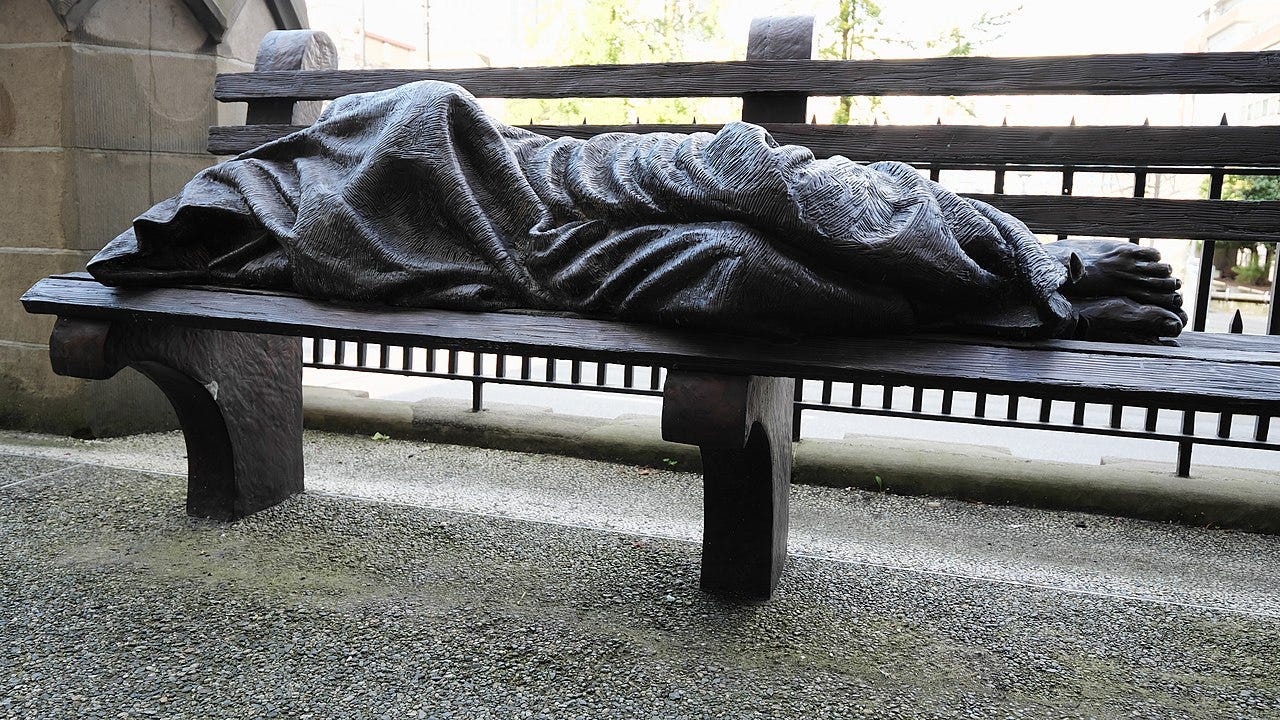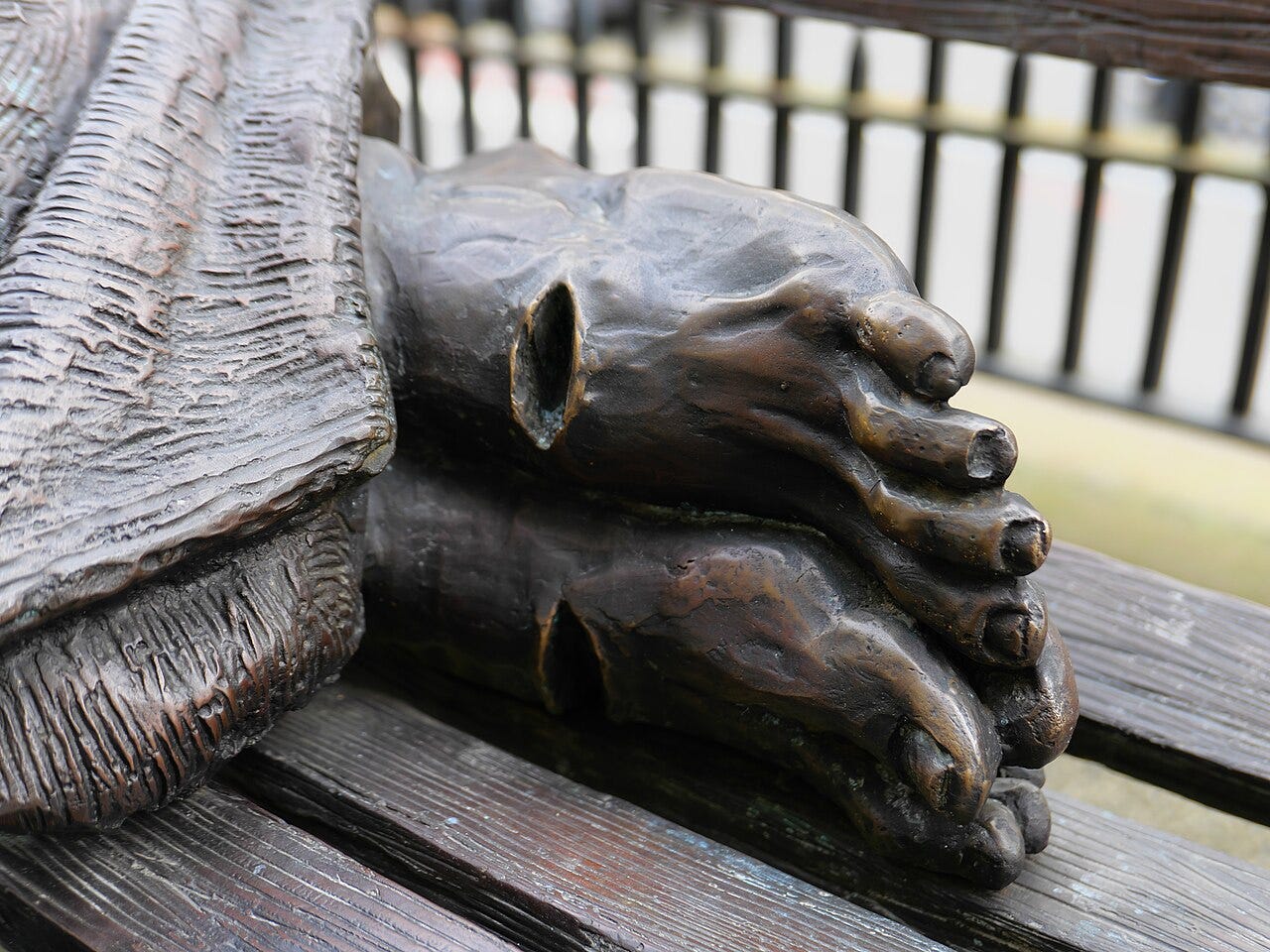A man lies on his side, taking up most of the space on a simple outdoor bench. A thin blanket over his head shields his face and most of his body from view. He’s probably been there all night despite the cold. Maybe he picked this bench because it’s one of the few nearby without slants, spikes, or armrests.
Such scenes are disturbingly common, particularly in larger cities. The vast majority of people—myself included—typically offer them nothing more than maybe a passing glance as they walk down the sidewalk or drive down the street.
Yet the man in this particular scene is bronze, a statue that someone made with purpose and someone else installed in a particular place as a work of sacred art.
He is Homeless Jesus, a creation of Canadian sculptor Timothy P. Schmalz.

Upon closer inspection, one can see the man’s sole identifying marks: nail holes through his feet, wounds of Christ’s crucifixion.

It reminds us that this man, like all humans, is made in the image and likeness of God—and his presence appropriately demands a response from each of us.
Whatever You Did for One of These Least Brothers of Mine
One can find Homeless Jesus statues in more than forty cities in the North America and more than twenty other cities around the world. The work is likely the most well-known of six sculptures in Timothy Schmalz’s “Matthew 25” collection.
The other five also depict vulnerable men in need, also identifiable as Jesus only through nail wounds in their hands or feet. All six sculptures remind us how we should behold and respond to those around us, especially those who are most easily and frequently ignored or forgotten.
Although these statues are located in many places around the world, currently only two cities have all six “Matthew 25” sculptures: Rome and Cleveland.
For my fellow residents of Greater Cleveland, here’s where you can find all six of them:
When I Was in Prison - Bridge CLE (formerly Family Ministry Center)
When I Was a Stranger - The Refugee Response at Urban Community School
And here’s a video from Community West Foundation in which you can see all of them and learn more.
Matthew 25
These sculptures comprise what’s called the “Matthew 25” collection because they’re based upon scenes from Matthew 25:31-46. Here’s that passage:
“When the Son of Man comes in his glory, and all the angels with him, he will sit upon his glorious throne, and all the nations will be assembled before him. And he will separate them one from another, as a shepherd separates the sheep from the goats. He will place the sheep on his right and the goats on his left.
Then the king will say to those on his right, ‘Come, you who are blessed by my Father. Inherit the kingdom prepared for you from the foundation of the world. For I was hungry and you gave me food, I was thirsty and you gave me drink, a stranger and you welcomed me, naked and you clothed me, ill and you cared for me, in prison and you visited me.’
Then the righteous will answer him and say, ‘Lord, when did we see you hungry and feed you, or thirsty and give you drink? When did we see you a stranger and welcome you, or naked and clothe you? When did we see you ill or in prison, and visit you?’
And the king will say to them in reply, ‘Amen, I say to you, whatever you did for one of these least brothers of mine, you did for me.’
Then he will say to those on his left, ‘Depart from me, you accursed, into the eternal fire prepared for the devil and his angels. For I was hungry and you gave me no food, I was thirsty and you gave me no drink, a stranger and you gave me no welcome, naked and you gave me no clothing, ill and in prison, and you did not care for me.’
Then they will answer and say, ‘Lord, when did we see you hungry or thirsty or a stranger or naked or ill or in prison, and not minister to your needs?’
He will answer them, ‘Amen, I say to you, what you did not do for one of these least ones, you did not do for me.’
And these will go off to eternal punishment, but the righteous to eternal life.”
A Call to See Suffering and Respond
Part of the mystery of the Incarnation is a reaffirmation or intense doubling-down on the idea that every human life has dignity and deserves our respect. This implies, particularly for Catholics, that we must then do something. (I realize that the Catholic emphasis on “works” can cause some consternation among other Christians, but my friend
did a good job discussing that recently—click here.)If nothing else, we can look to the Parable of the Good Samaritan as a guide for what we should do in the face of others’ suffering. Namely, we should run toward it and do what we can to alleviate it.
What might be some specific things we can do? The Catholic Church calls them the “Corporal Works of Mercy,” which are seven actions based upon Matthew 25 and related biblical teachings. Here they are:
Feed the hungry
Give drink to the thirsty
Shelter the homeless
Visit the sick
Visit the prisoners
Bury the dead
Give alms to the poor
Clearly, these all directly affect the most vulnerable among us. For more about these actions including practical ways to integrate them into your life, visit this site from the U.S. Conference of Catholic Bishops.
Also, save the dates of Sept. 20-27, 2025.
In an attempt to make service—including those closely aligned with the Corporal Works of Mercy—more of a habit in our daily lives, my family and I (along with many amazing volunteers) will be facilitating the 5th Annual Vincent William Baran Day of Service this September.
So, I invite you to save the dates of Sept. 20-27. You can also click here for more information and to sign up for reminders and updates. Even if you don’t live in the Greater Cleveland/Northeast Ohio region, consider joining us through a work of in-person service in your area. We’re continually exploring ways to make it easy for people anywhere to serve.
We’ve had about 2,000 volunteers across the past four years. And as amazing as it is to support many amazing nonprofits through this work, it’s even more amazing to hear about the change such work has done in the lives of our volunteers. If nothing else, such service takes people outside of their normal (often comfortable) environments and social circles, giving them a new awareness and sensitivity to the human suffering in our midst.
Be it through actual service or works of art like Homeless Jesus, may we all find ways to truly see those around us—and to help them when and where we can. For as St. John of the Cross is often quoted as saying, “At the evening of life, we shall be judged on our love. Learn to love as God desires to be loved and abandon your own ways of acting.”





For me, this article is a reminder of the power of choice.